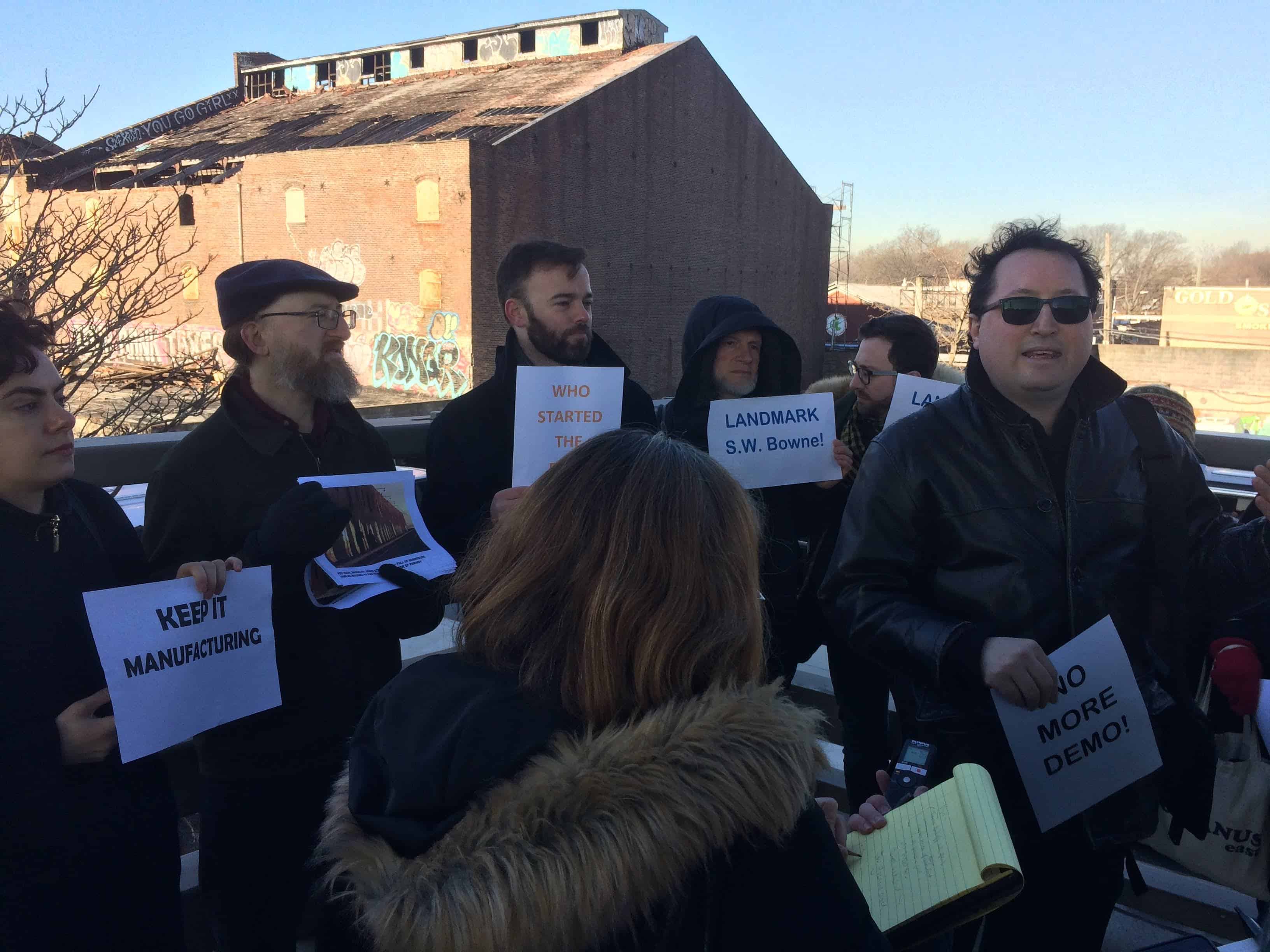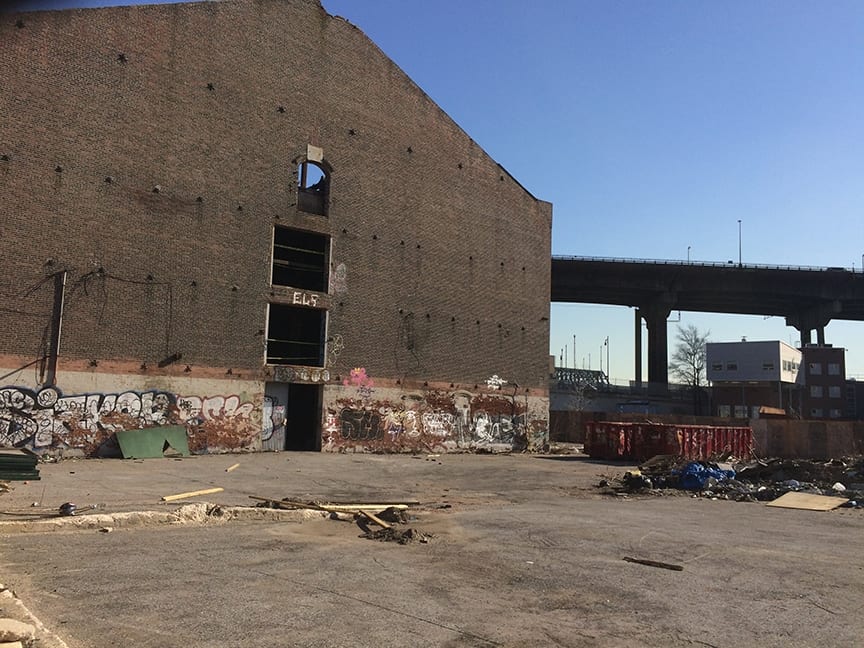 The Gowanus Landmarking Coalition wants to thwart the planned demolition of the S.W. Bowne Grain Storehouse, a circa-1886 brick industrial structure at 595 Smith Street. On the morning of March 13, the preservationists held a rally on the Hamilton Avenue Bridge over the Gowanus Canal.
The Gowanus Landmarking Coalition wants to thwart the planned demolition of the S.W. Bowne Grain Storehouse, a circa-1886 brick industrial structure at 595 Smith Street. On the morning of March 13, the preservationists held a rally on the Hamilton Avenue Bridge over the Gowanus Canal.
Last year, a fire damaged the Storehouse, which the Chetrit Group, a real estate development company, bought in 2007. Chetrit also purchased three more parcels along the Gowanus Canal at the foot of Smith Street, demolishing warehouses on the lots. The Society of Industrial Archaeology, a D.C.-based nonprofit, formally requested landmark status for the Storehouse in 2009, and the Gowanus Landmarking Coalition has since taken up the cause with the New York City Landmarks Preservation Commission (LPC).
On March 5, 2019, the New York City Department of Buildings (DOB) received two complaints about demolition work despite a Stop Work Order (SWO) at 595 Smith Street. DOB inspectors confirmed the violation the same day and also cited the contractor for missing guardrails, excessive debris, and expired disability insurance.
Four days later, the DOB received another complaint about the erection of demolition scaffolding and visited the location again. The crew had continued to ignore the SWO and received an additional fine for working on a Saturday without a DOB After Hours Variance. When the DOB followed up on March 11 to ensure compliance with the SWO, work had stopped, but the inspector noticed a large hole in the construction fence and handed out a ticket for failure to properly safeguard the site.
Wouldn’t allow demolition
At the time of the 2018 fire, councilman Carlos Menchaca deemed the incident “highly suspicious” and declared that he would “not allow demolition by neglect or fire to prompt zoning changes” in Red Hook’s Industrial Business Zone. The New York City Fire Department (FDNY) subsequently concluded that the fire was intentional, but the investigation remains open.
Menchaca attended the rally on March 13, relaying news that Chetrit’s disregard of DOB instructions had landed the developer in potential legal trouble. “The Department of Buildings says that the borough attorney is commencing a process to issue a criminal court summons based on repeated violations,” Menchaca announced. “We are still trying to get clarity on what the enforcement timeline looks like. Until then, we must not relent until demolition stops and the preservation of this gorgeous, beautiful building commences.”
Menchaca disclosed that, during his first term in the City Council, Chetrit had come to him with a plan to rezone 595 Smith Street for residential towers. He recalled his response: “‘This is a manufacturing district. Give me another plan.’ They came back with towers of housing with the first two floors of manufacturing. That is not what we want on this site.”
The councilman bemoaned “the corporate greed of developers that can’t wait to see me gone – I’ll be done in three years – to change the zoning here. And that’s why we have to be vigilant.”
Brad Vogel of the Gowanus Landmarking Coalition spoke of his group’s willingness to undertake “a multi-pronged effort to keep this building standing. First and foremost, we must get the FDNY to complete the investigation.” According to Vogel, the LPC has stated that it won’t consider landmarking the Storehouse until the fire investigation has concluded.
The FDNY’s ongoing work did not prevent the Department of Buildings from issuing a full demolition permit for 595 Smith Street earlier this winter. Chetrit had filed an application for demolition in September, 2017, but did not submit all the required materials until February, 2019, at which point the DOB immediately approved the request.
A statutory process determines DOB approvals. “If a property owner wishes to demolish their non-landmarked building in New York City,” said spokesperson Andrew Rudansky, “they must hire an architect or an engineer to draw up plans for the demolition” and “must then file an application with the Department of Buildings which includes these plans. If the application is complete, and found to be in total compliance with all of the applicable provisions in the NYC Zoning Resolution and NYC Construction Codes, they will get DOB approval for the project.”
The SWO at 595 Smith Street owes to an earlier, unpermitted demolition attempt from 2018. The DOB issued the order one week after last year’s fire at the Storehouse.
Although Chetrit has now resolved the substance of the complaint by securing the correct permit for demolition, the SWO remains in effect because the developer hasn’t remedied the violation on paper. “The issue is that they never requested the Stop Work Order to be removed, and as such DOB has not yet rescinded the order,” Rudansky explained.
The Gowanus Landmarking Coalition’s rally gathered a small crowd of hopeful history buffs and promoters of manufacturing and maritime industry in Red Hook. These included Simeon Bankoff, the executive director of the Historic Districts Council; author Joseph Alexiou, whose history Gowanus: Brooklyn’s Curious Canal was published by NYU Press in 2015; and Carolina Salguero, the founder of PortSide New York.
“One of the great marvels of Brooklyn, of New York City, is the adaptive reuse of the historic properties of the waterfront,” Bankoff asserted. “They’re being reused for shopping; they’re being reused for light industry. The Fairway in Red Hook is one example of a warehouse building being reused for the continued distribution of consumer goods.”
Alexiou praised Menchaca for showing up to the event. “I think the next step, to me, is to keep hitting up all the local politicians,” he said.
Salguero urged attention to the adjacent problem of the crumbled bulkheads on the Gowanus Canal’s Smith Street shoreline. She blamed regulations by the New York State Department of Environmental Conservation that prevent the reconstruction of waterfront infrastructure like piers and bulkheads once decay has claimed 50 percent or more of it.
The graffiti-covered Storehouse has decayed, too, but Vogel believes it could be rehabilitated. The building’s claim to historical significance rests in part on a landmark New York State labor case prompted by an injury on the premises.
In 1916, S.W. Bowne, the president and primary shareholder of the S.W. Bowne Company, lost a leg to the machinery at the facility while helping his workers unload lumber. He successfully sued for workman’s compensation, claiming that his role as president made him an employee of his own enterprise (which manufactured cattle foods). His board of directors sued in turn, arguing that because Bowne owned the company, he was not operating on the orders of the corporation, as an employee would be, when he incurred injury. The New York Court of Appeals disagreed, upholding the original ruling.









